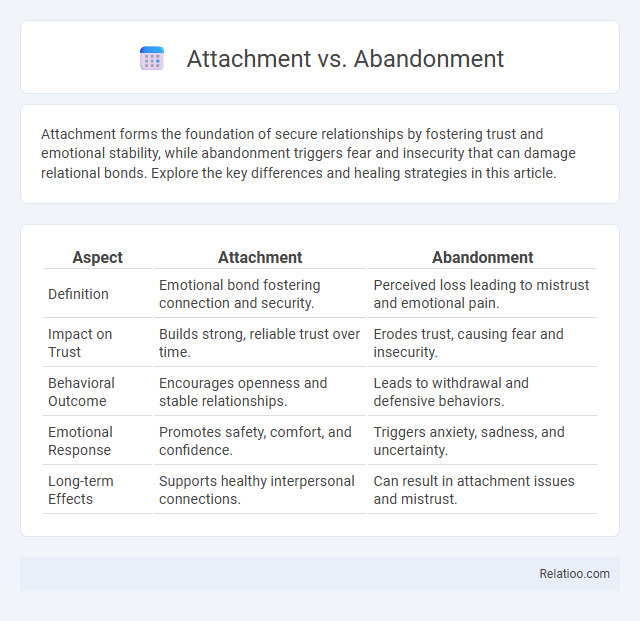Attachment forms the foundation of secure relationships by fostering trust and emotional stability, while abandonment triggers fear and insecurity that can damage relational bonds. Explore the key differences and healing strategies in this article.
Table of Comparison
| Aspect | Attachment | Abandonment |
|---|---|---|
| Definition | Emotional bond fostering connection and security. | Perceived loss leading to mistrust and emotional pain. |
| Impact on Trust | Builds strong, reliable trust over time. | Erodes trust, causing fear and insecurity. |
| Behavioral Outcome | Encourages openness and stable relationships. | Leads to withdrawal and defensive behaviors. |
| Emotional Response | Promotes safety, comfort, and confidence. | Triggers anxiety, sadness, and uncertainty. |
| Long-term Effects | Supports healthy interpersonal connections. | Can result in attachment issues and mistrust. |
Understanding Attachment: Foundations and Forms
Understanding attachment involves recognizing its foundational role in emotional development, manifested through secure, anxious, and avoidant attachment styles that shape interpersonal relationships. Attachment theory highlights the importance of early caregiver interactions, which establish patterns of trust and emotional security or insecurity. Differentiating attachment from abandonment reveals how consistent caregiving fosters healthy bonds, whereas abandonment, characterized by neglect or loss, disrupts emotional stability and attachment formation.
The Psychology Behind Abandonment
The psychology behind abandonment centers on the deep emotional pain and fear triggered when individuals perceive that they have been rejected or left behind, often leading to attachment wounds that affect their future relationships. Your sense of self-worth and trust in others can be profoundly impacted by early experiences of abandonment, creating patterns of anxiety or avoidance in attachment styles. Understanding these psychological mechanisms is essential for healing and developing healthier emotional connections.
Attachment vs. Abandonment: Key Differences
Attachment involves forming secure emotional bonds that foster trust and a sense of safety, while abandonment refers to the experience of being deserted or neglected, often leading to emotional distress and mistrust. Your ability to distinguish these concepts is crucial in understanding how early relationships impact mental health and interpersonal connections. Recognizing the key differences between attachment and abandonment can guide therapeutic approaches aimed at healing attachment wounds and building resilience.
Early Childhood Experiences and Emotional Bonds
Early childhood experiences play a critical role in shaping your emotional bonds, where secure attachment fosters trust and emotional stability, while abandonment can lead to feelings of insecurity and difficulty forming relationships. Attachment theory emphasizes the importance of consistent caregiving in developing healthy emotional connections, contrasting with the trauma and emotional challenges caused by abandonment. Understanding these early influences helps in addressing emotional development and improving interpersonal relationships throughout life.
Signs of Secure vs. Insecure Attachment
Signs of secure attachment include consistent emotional availability, trust, and the ability to seek comfort during stress. Insecure attachment often manifests as anxiety, avoidance, or ambivalence, leading to difficulties in forming healthy relationships. Understanding these signs helps you recognize the impact of abandonment on attachment patterns and promote emotional well-being.
Impact of Abandonment on Mental Health
Abandonment, distinct from secure attachment, significantly harms mental health by triggering feelings of rejection, low self-worth, and chronic anxiety. Experiencing abandonment often leads to attachment disorders, depression, and difficulties in forming trusting relationships. Understanding the psychological effects of abandonment is crucial for developing effective therapeutic interventions to promote emotional resilience.
Navigating Relationships: Attachment Styles Explained
Navigating relationships requires understanding the distinct dynamics of attachment, abandonment, and detachment, which shape emotional connections and interpersonal behavior. Attachment styles, including secure, anxious, avoidant, and disorganized, influence how individuals form bonds and respond to separation or perceived rejection. Recognizing these patterns aids in managing relationship expectations, fostering resilience, and promoting healthier emotional intimacy.
Healing from Abandonment Wounds
Healing from abandonment wounds requires understanding the differences between attachment and abandonment. Attachment forms the emotional bond essential for healthy relationships, while abandonment involves the painful experience of loss or neglect, often leading to deep emotional scars. Your healing journey focuses on rebuilding trust, nurturing secure attachments, and addressing abandonment trauma through therapeutic support and self-compassion.
Building Healthy Attachments in Adulthood
Building healthy attachments in adulthood fosters emotional resilience and secure relationships by promoting trust, empathy, and consistent communication. Recognizing and addressing patterns of abandonment helps prevent fear-driven behaviors and emotional withdrawal, enabling individuals to form stable bonds. Therapeutic interventions and self-awareness practices support healing from past abandonment experiences, enhancing the ability to maintain secure attachments.
Strategies for Overcoming Fear of Abandonment
Overcoming the fear of abandonment involves cognitive-behavioral therapy techniques that help individuals reframe negative beliefs about relationships and develop secure attachment patterns. Building strong emotional boundaries and practicing self-soothing methods enhance resilience against abandonment anxieties. Engaging in consistent communication and seeking supportive social networks further reduces the emotional impact of perceived or real abandonment.

Infographic: Attachment vs Abandonment
 relatioo.com
relatioo.com